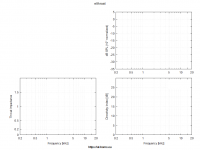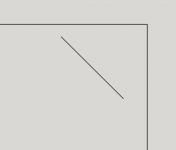A problem with this is that it is not easy to tell if this will cause audible problems by looking at linear models (frequency responses, etc.).
This is a point that I have often tried to make in regards to waveguide "distortion". The "system" is not linear, neither the waveguide nor our hearing. But people seem to only prescribe these problems to the waveguide, when in fact, for the most part, the waveguide distortion is minimal. Our hearing is not. HOMs are likely to be more audible at high SPLs because our hearing is more sensitive to group delay at higher SPLs. Hence you can look at the linear and nonlinear aspects of the waveguide all you want but you won't find answers because the issue is with our hearing.
Were you able to include the side or rear vents as BEM elements? It was this together with trying to work out a practical way to simulate real materials that caused me to shelve this idea.
Would you mind sharing an Akabak project or ABEC script I would like to see what you did 🙂
The vents themselves still have to be cut out of the 2D/3D BEM model. The LEM approach I used is an approximation of the effect of damping material. It cannot specify where that damping material is physically located unfortunately.
The LEM approach is like having an electric lowpass filter just on the back wave. This would be equivalent to wrapping the back of a driver uniformly in damping material. Not perfectly realistic, but good enough for determining what kind of lowpass characteristics one might need for a passive cardioid.
Where this approach really falls apart is if your vents are not symmetric. The longer a wave travels through damping material, the more the effect. Since the LEM approach cannot account for physical distance, it cannot accurately do these types of scenarios.
That said, for simple symmetric side vent applications, it seems to at least get in the ballpark, which is one step better than cut and try for everything 😉
I am using this approach to figure out what kind of lowpass characteristics are needed by the damping material for a given cabinet/vent shape. From there it becomes what damping materials at what thicknesses at what compression amount would create that result.
I am currently running a long sim and can try and upload an example soon. Most of my examples have been in 2D for now since I have been playing around with the concept and have not wanted to wait for 3D.
Beta version of Ath 4.7.1, including a demo: https://at-horns.eu/release/elthroat+Ath-4.7.1beta.zip
Thanks Marcel!
If you read from this post down it might help work out the problem, the graphs need to have the correct label for the report to find the data.
Acoustic Horn Design – The Easy Way (Ath4)
Acoustic Horn Design – The Easy Way (Ath4)
I've all but settled on a 24" round freestanding waveguide, a larger version of the sand horn. It will need to be in the corner of the room such that one edge will be 4 - 6 inches from the front wall, and the other will be 6 - 8 inches from the side wall. Is this such a problem that I'm better off going for a smaller WG that has more space from the walls?
Attachments
Last edited:
If you read from this post down it might help work out the problem, the graphs need to have the correct label for the report to find the data.
Acoustic Horn Design – The Easy Way (Ath4)
Adding a GraphHeader worked. Thanks Fluid
Thinking about HOMs & eventually listening to them...
What determines how much sound comes from resonances (HOMs) within a waveguide?
The shape of the waveguide, including its terminations, sets up the spectrum of higher order modes - as Dr Geddes' analysis shows. That's like the modes of the stretched string - they exist whether or not they are driven.
But, how much sound do those emit when driven from the throat? Lets assume plane-wave excitation with white/pink noise so that all modes can be excited.
How loudly does a mode sound? That depends on how much sound is diffracted into that mode - also determined by the shape of the waveguide.
All waveguides, even well-terminated OS waveguides, have a spectrum of HOMs.
Adding a region of more rapid curvature, changes the HOM spectrum but, at least as importantly for subtle changes in shape, increases diffraction which scatters sound into HOMS so that they get louder. The effect is strongest for deviations from OS near the throat.
A problem with this is that it is not easy to tell if this will cause audible problems by looking at linear models (frequency responses, etc.).
I found out almost a decade ago that I can't stand listening to some well-known softly-rounded diffraction horns in comparison with a similar size waveguide in GedLee Harper speakers (with or without their foam plugs).
The defects of a diffraction horn might not be immediately obvious without a comparison, but once they are heard, they are hard to forget, and become a big distraction, at least for me.
Ken
Interesting observations!
I think the (total) size of the horn should not be underestimated in this regard. IOW what's left of (additional) HOMS/diffraction artefacts because of a slot, after the wavefront leaves the mouth of a big horn?
I wouldn't go smaller, in that situation I'd go as large as possible.Is this such a problem that I'm better off going for a smaller WG that has more space from the walls?
I can't stand listening to some well-known softly-rounded diffraction horns Ken
Why not share the horn? isn't this useful information to other around?
Would anyone care to take a stab at an idea that I have?
I am curious; if we looked at predicted frequency responses - from sims - and looked at the group delay derived from the frequency response - Hilbert transform to phase and phase to group delay - and all that, could something be seen in excess group delay, at any frequencies I guess. I'd expect this to happen at resonances in a diffraction type of device. It could then be correlated to perception - something that IMO is not available today.
I am curious; if we looked at predicted frequency responses - from sims - and looked at the group delay derived from the frequency response - Hilbert transform to phase and phase to group delay - and all that, could something be seen in excess group delay, at any frequencies I guess. I'd expect this to happen at resonances in a diffraction type of device. It could then be correlated to perception - something that IMO is not available today.
A Brep surface made from a mesh will have too many facets, you have more luck trying to thicken a regular surface. Can you create that guide using Grid Export or is it an STL you got from somewhere?
The only option I found if you only have a mesh is to use the Brep surface to cut a solid block then use solid modelling tools on the block to make the back however you want it.
I attached a guide describing what I did in this post before mabat released the Fusion scripts.
Acoustic Horn Design – The Easy Way (Ath4)
The only option I found if you only have a mesh is to use the Brep surface to cut a solid block then use solid modelling tools on the block to make the back however you want it.
I attached a guide describing what I did in this post before mabat released the Fusion scripts.
Acoustic Horn Design – The Easy Way (Ath4)
Under wine and Mac OS, what should
OutputRootDir =
in ath.cfg be set to?
I just comment that line out (or delete it) so it outputs to whatever the current working directory is.
Answers
Acoustic Horn Design – The Easy Way (Ath4)
@TNT - yes, the sound coming out with a phase/time delay is the same point Earl makes about group delay. It's a good hypothesis in the current state of knowledge, i.e. Earl's analysis plus collective observations and some physical intuition.
Acoustic Horn Design – The Easy Way (Ath4)
@Ro808 - Thanks. If I understand your question correctly: no, most of the energy leaves the mouth, so if a HOM is excited deep in the horn, the effect reaches the listener. I feel I might be misunderstanding your point.
Acoustic Horn Design – The Easy Way (Ath4)
@Drofdissonance - it was XT1086. At first I thought this sounded fine, when used over a rather narrow bandwidth, but later I started to hear its squawk and eventually realized it couldn't be EQ'd. You can see my first DIYA thread in 2008/9 which started with me measuring and ended a bit before I bought the Harpers. You might guess why I chose to post where I did in this thread - I've been thinking of posting something like this for a while.
Ken
Acoustic Horn Design – The Easy Way (Ath4)
@TNT - yes, the sound coming out with a phase/time delay is the same point Earl makes about group delay. It's a good hypothesis in the current state of knowledge, i.e. Earl's analysis plus collective observations and some physical intuition.
Acoustic Horn Design – The Easy Way (Ath4)
@Ro808 - Thanks. If I understand your question correctly: no, most of the energy leaves the mouth, so if a HOM is excited deep in the horn, the effect reaches the listener. I feel I might be misunderstanding your point.
Acoustic Horn Design – The Easy Way (Ath4)
@Drofdissonance - it was XT1086. At first I thought this sounded fine, when used over a rather narrow bandwidth, but later I started to hear its squawk and eventually realized it couldn't be EQ'd. You can see my first DIYA thread in 2008/9 which started with me measuring and ended a bit before I bought the Harpers. You might guess why I chose to post where I did in this thread - I've been thinking of posting something like this for a while.
Ken
I'm working on that - making excess group delay part of the standard report.Would anyone care to take a stab at an idea that I have?
I am curious; if we looked at predicted frequency responses - from sims - and looked at the group delay derived from the frequency response - Hilbert transform to phase and phase to group delay - and all that, could something be seen in excess group delay, at any frequencies I guess. I'd expect this to happen at resonances in a diffraction type of device. It could then be correlated to perception - something that IMO is not available today.
Last edited:
You need to create ("loft") the surface from splines imported via the Add-ins included in the Ath package. It doesn't work with STLs, I suppose.I'm trying to print a Tritonia style horn.
What do you guys use to make the body thicker?
I tried fusion thicken feature but not having any luck...
This may be tricky sometimes.
Last edited:
- Home
- Loudspeakers
- Multi-Way
- Acoustic Horn Design – The Easy Way (Ath4)



